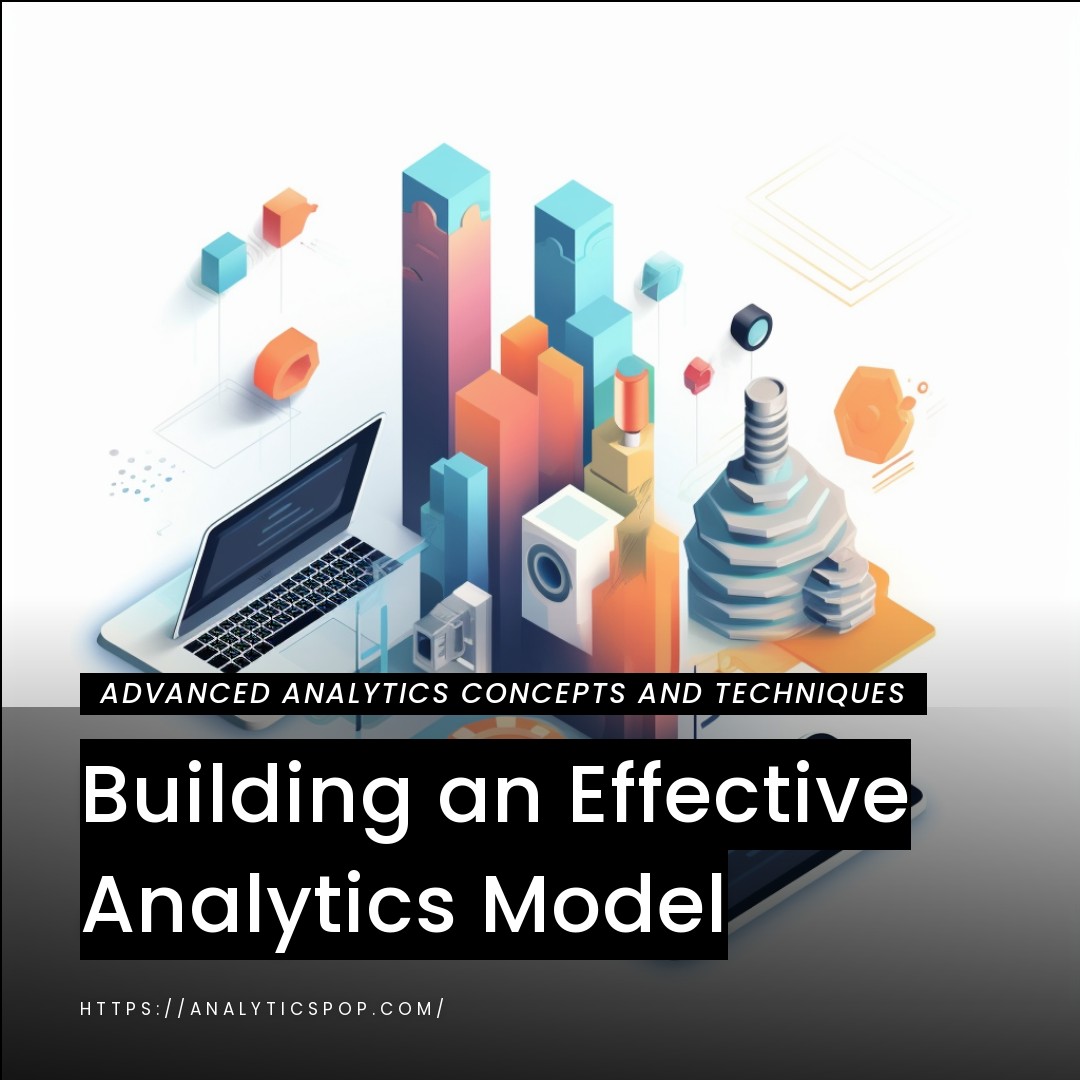Building an Effective Analytics Model: Key Steps to Success
Building an effective analytics model requires a well-defined and structured approach.
The first step is to identify the business problem the model intends to solve.
- Once the problem is defined, the next step is to gather relevant data. This data may come from sources like internal databases, external APIs, or third-party data providers.
- The third step is to preprocess and clean the data to ensure it is accurate and ready for analysis. This involves removing duplicates, handling missing values, and transforming the data into a suitable format for research.
- Next, choosing the right analytical technique or algorithm for the problem at hand is essential. This may involve regression analysis, clustering, classification, or other methods depending on the nature of the problem and the available data.
- Once the analytical technique is chosen, the next step is to validate the model using appropriate testing and validation techniques. This ensures that the model is accurate and reliable in its predictions.
- Finally, the model is deployed into production and monitored over time to ensure that it delivers valuable insights and remains up-to-date with changes in the underlying data.
With these critical steps in mind, businesses can build effective analytics models that drive valuable insights and business outcomes.
Defining Your Business Problem
Defining your business problem is a crucial first step in any data analytics project. This requires a clear understanding of the specific issue you want to address and the business objectives you hope to achieve.
To define your business problem, ask questions such as: What are the pain points in our business operations? Where are we experiencing inefficiencies or bottlenecks? What are the areas of our business where we need to improve performance?
It is also essential to consider the broader context in which the problem exists. For example, what external factors may be contributing to the problem, such as market changes or customer behavior shifts?
Once you clearly understand the problem, defining the specific objectives you hope to achieve through your analytics project is essential. These objectives are specific, measurable, achievable, relevant, and time-bound (SMART).
For example, if your business problem is a high customer churn rate, your objective might be to reduce churn by 20% within the next six months.
By defining your business problem and objectives clearly, you can focus your analytics efforts on the areas that will have the most significant impact on your business and ensure that you can measure the success of your analytics project in delivering tangible business outcomes.
Identifying the business problem you want to solve with analytics
Identifying the business problem you want to solve with analytics is a critical first step in any data-driven project. To determine the problem, start by looking at your business operations and processes, and identify areas where you are experiencing inefficiencies, bottlenecks, or challenges.
For example, you must help manage your inventory effectively or experience a high customer churn rate. Alternatively, you might be looking to optimize your pricing strategy or improve the accuracy of your sales forecasts.
Once you have identified the problem, consider whether analytics can help to address it. This might involve analyzing large volumes of data to identify patterns and trends or using predictive modeling to forecast future outcomes.
Defining the specific business objectives you hope to achieve through your analytics project is also essential. These objectives should be clear, measurable, achievable, relevant, and time-bound (SMART).
For example, if your business problem is a high customer churn rate, your objective might be to reduce churn by 20% within the next six months.
By identifying the business problem and objectives clearly, you can focus your analytics efforts on the areas that will have the most significant impact on your business and ensure that you can measure the success of your analytics project in delivering tangible business outcomes.

Developing a clear understanding of the problem's root causes and impact
A clear understanding of the root causes and impact of the business problem is critical to designing an effective analytics solution. This requires a deep dive into the data and discussions with subject matter experts and stakeholders.
To understand the root causes of the problem, start by looking at the data and identifying patterns and trends. This might involve analyzing customer behavior, sales data, or operational metrics. You may also need to collect additional data to fill in gaps or validate your findings.
Once you have identified the potential causes of the problem, it is essential to validate these hypotheses with subject matter experts and stakeholders. This might involve conducting interviews or focus groups to gather feedback on the proposed causes and their potential impact.
At the same time, it is essential to understand the impact of the problem on your business. This might include analyzing the financial implications, such as lost revenue or increased costs, as well as the effect on customer satisfaction or brand reputation.
By clearly understanding the root causes and impact of the business problem, you can design an analytics solution that is targeted, effective, and aligned with your business objectives. This will enable you to drive actionable insights to help you address the problem and achieve your desired outcomes.
Defining specific goals and metrics for the analytics model
Defining specific goals and metrics for the analytics model ensures your solution delivers tangible business value. Goals and metrics should align with your overall business objectives and be specific, measurable, achievable, relevant, and time-bound (SMART).
To define your goals and metrics, start by considering the specific business problem you are trying to solve. What outcomes do you hope to achieve through your analytics solution? What are the key performance indicators (KPIs) that are most important to your business’s success?
For example, if your business problem is a high rate of customer churn, your goals and metrics might include the following:
- Reduce churn rate by 20% within the next six months
- Increase customer retention by 10% within the next year
- Improve customer satisfaction scores by 15% within the next year
Once you have defined your goals and metrics, it is essential to ensure that you have the data and analytics capabilities to measure and track these metrics over time. This might involve building custom reports or dashboards or integrating your analytics solution with other systems and tools.
By defining specific goals and metrics for your analytics model, you can ensure that you can measure the impact of your solution on your business outcomes. This will enable you to continuously refine and improve your analytics approach and demonstrate the value of your analytics investment to key stakeholders within your organization.
Developing the Analytics Model
Developing the analytics model is a critical step in any data-driven project. It involves building a model to analyze and interpret your data effectively to drive valuable insights and outcomes. Here are some essential steps to follow when developing your analytics model:
- Define the problem: Start by defining the business problem you want to solve through analytics and identify the specific data sources you will need to use to build your model.
- Preprocess and clean the data: Ensure your data is clean and ready for analysis by performing tasks such as removing duplicates, handling missing values, and transforming the data into a suitable format for research.
- Choose the correct analytical technique: The most appropriate analytical technique or algorithm for your model depends on the nature of the problem and the available data. This might involve regression analysis, clustering, classification, or other methods.
- Train and validate the model: Train your model on a subset of your data, and validate its accuracy and reliability using appropriate testing and validation techniques.
- Deploy and monitor the model: Once your model is validated, deploy it into production and monitor its performance over time to ensure that it delivers valuable insights and remains up-to-date with changes in the underlying data.
By following these steps, you can develop an analytics model that is effective, reliable, and aligned with your business objectives. This will enable you to drive valuable insights and outcomes from your data and continuously improve your analytics approach.

Collecting relevant data and preparing it for analysis
Collecting relevant data and preparing it for analysis is critical in any data-driven project. Here are some key steps to follow when collecting and organizing your data:
- Identify the data sources: Identify the internal and external data sources that are relevant to the business problem you are trying to solve. This might include data from your CRM, ERP, marketing automation system, or external data providers.
- Collect the data: Collect the data from the identified sources and store it in a centralized location, such as a data warehouse or data lake.
- Clean and preprocess the data: Ensure your data is clean and ready for analysis by performing tasks such as removing duplicates, handling missing values, and transforming the data into a suitable format for research.
- Integrate the data: Integrate the data from different sources to create a unified view of the data. This might involve joining data tables, aggregating data, or creating new variables based on the available data.
- Validate the data: The accuracy and completeness by comparing it with external data sources or conducting manual checks.
- Define the data schema: Define the data schema or model used to analyze the data. This might involve creating tables, defining fields, or establishing relationships between data tables.
Following these steps ensures your data is clean, accurate, and ready for analysis. This will enable you to drive valuable insights and outcomes from your data and continuously improve your analytics approach.
Selecting appropriate data analysis techniques and tools
Selecting appropriate data analysis techniques and tools is essential to ensure you can derive valuable insights from your data. Here are some key considerations when selecting data analysis techniques and tools:
- Analytical techniques: Select the most appropriate analytical techniques or algorithms for your data analysis depending on the nature of your business problem and the available data. This might involve regression analysis, clustering, classification, time series analysis, or other techniques.
- Data visualization tools: Select tools that enable you to communicate insights and findings to stakeholders effectively. This might include tools such as Tableau, Power BI, or D3.js.
- Programming languages: Select programming languages best suited for the task at hand. Popular languages for data analysis include Python and R.
- Statistical analysis software: Select statistical analysis software that enables you to perform complex statistical analyses on your data. Popular software includes SPSS, SAS, and Stata.
- Machine learning platforms: If you are working with large volumes of data or need to perform complex machine learning analyses, consider using machine learning platforms such as TensorFlow or PyTorch.
By selecting appropriate data analysis techniques and tools, you can ensure that you can effectively analyze your data and derive valuable insights from it. This will enable you to make informed business decisions and continuously improve your analytics approach.
Iteratively refining and testing the analytics model to ensure accuracy and relevance.
Iteratively refining and testing the analytics model is essential to ensure it remains accurate and relevant. Here are some critical steps to follow when refining and testing your analytics model:
- Continuously monitor the data: Continuously monitor the data used in the analytics model to ensure that it remains accurate and up-to-date. This might involve setting up alerts for data anomalies or discrepancies or conducting regular data audits.
- Refine the model: Continuously refine the analytics model to ensure it remains accurate and effective. This might involve adjusting the model’s parameters, incorporating new data sources, or using new analytical techniques.
- Validate the model: Continuously validate the accuracy and reliability of the analytics model using appropriate testing and validation techniques. This might involve testing the model on new data, conducting A/B tests, or comparing the model’s predictions with actual outcomes.
- Evaluate the model’s performance: Continuously evaluate the performance of the analytics model to ensure that it delivers the desired outcomes. This might involve comparing the model’s predictions with actual products or conducting customer satisfaction surveys.
By following these steps, you can ensure that your analytics model remains accurate and relevant over time and continues to deliver valuable insights and outcomes for your business. This will enable you to make informed business decisions and continuously improve your analytics approach.
FAQs

Q: What are the critical components of an effective analytics model?
An effective analytics model consists of several key features, including:
- A clearly defined business problem: The analytics model should be designed to solve a specific business problem or address a particular pain point within the organization.
- Relevant and high-quality data: The analytics model should use appropriate and high-quality data that is accurate, complete, and up-to-date.
- Appropriate analytical techniques: The analytics model should use proper analytical methods and algorithms well-suited to the problem and the available data.
- Data visualization: The analytics model should incorporate data visualization tools that enable stakeholders to interpret and understand the insights and findings easily.
- Continuous refinement: The analytics model should be refined and improved over time to ensure that it remains accurate and relevant in changing business needs and data.
- Effective communication: The analytics model should be communicated to organizational stakeholders to ensure the insights and findings are understood and acted upon.
By incorporating these key components into the design of an analytics model, organizations can effectively leverage data to drive insights, inform decision-making, and improve business outcomes.
Q: How do I select the proper data analysis techniques for my business problem?
Selecting the proper data analysis techniques for your business problem requires careful consideration of several factors. Here are some critical steps:
- Define the problem: Clearly define the business problem you are trying to solve and determine the key questions you want to answer with your analysis.
- Identify the data: Identify the sources relevant to the problem and the questions you are trying to answer.
- Analyze the data: Analyze the data to understand its structure, quality, and complexity.
- Select the analytical techniques: Select the appropriate analytical methods based on the nature of your data, the problem you are trying to solve, and the questions you want to answer. This might involve regression analysis, clustering, classification, time series analysis, or other techniques.
- Evaluate the results: Evaluate the analysis results to ensure they are meaningful, relevant, and actionable.
- Refine the analysis: Refine the research as necessary based on the results, and repeat the process until the insights and findings are precise, accurate, and relevant.
When selecting data analysis techniques, it is essential to consider the unique needs and characteristics of your business problem, as well as the available data and resources. It is also helpful to seek input from subject matter experts, data scientists, or analytics professionals to ensure you select the most appropriate techniques for your problem.
Q: What are some common pitfalls to avoid when building an analytics model?
Building an analytics model can be a complex process, and there are several common pitfalls that organizations should be aware of to avoid them. Here are some of the most common pitfalls to avoid:
- Lack of clear business objectives: Building an analytics model without clear business objectives can lead to a lack of focus and direction. Defining clear and specific business objectives before starting the analytics project is essential.
- Insufficient or poor quality data: The quality and quantity of data used in an analytics model can significantly impact the accuracy and relevance of the insights derived. It is essential to use high-quality and relevant data for the analysis.
- Overfitting: Overfitting occurs when a model is too closely tailored to the data used in the analysis and, as a result, performs poorly on new or unseen data. It is essential to strike a balance between the complexity of the model and its ability to generalize to new data.
- Lack of validation: Please validate the accuracy and reliability of the analytics model to ensure accurate insights. It is essential to use appropriate testing and validation techniques to ensure that the model is accurate and reliable.
- Poor communication: Please communicate the insights and findings derived from the analytics model to ensure their adoption and impact. It is essential to use effective data visualization and storytelling techniques to share insights and results clearly and concisely.
By avoiding these common pitfalls and following best practices for building an analytics model, organizations can maximize the impact of their data-driven insights and achieve their business objectives.



